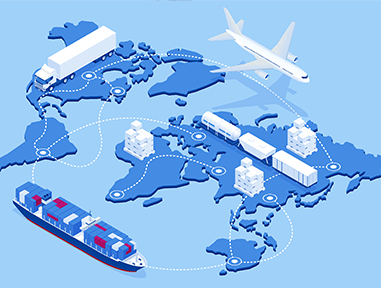 Getting products into consumers’ hands is taking longer than in pre-COVID times. A combination of factors, including concerns with border crossing, labor shortages, and manufacturing slowdowns are wreaking havoc on the domestic supply chain and disrupting commerce across multiple industries.
Getting products into consumers’ hands is taking longer than in pre-COVID times. A combination of factors, including concerns with border crossing, labor shortages, and manufacturing slowdowns are wreaking havoc on the domestic supply chain and disrupting commerce across multiple industries.
Contact center agents are on the front lines of this growing problem, answering customer inquiries and giving shipping updates. Understanding the past and current disruptions may just give your company the advantage when planning for these increased customer service needs.
Manufacturing Slowdowns
The Situation. Anyone who has tried to make a purchase in the last year has probably experienced the effects of the disrupted supply chain in America. Products such as vehicles and electronics have become more scarce than ever before.
At the onset of the COVID-19 pandemic, many manufacturers slowed down the production of items, such as computer chips, under the assumption that buying would lag during the pandemic. Instead, consumers shifted to online marketplaces to continue participation in the economy. Most notably, the auto industry expected the need for vehicles to ease as citizens sheltered in place. On the contrary, many took the opportunity to order new cars directly to their homes in preparation for everyday life returning to normal. Automotive factory lines have now nearly halted due to shortages of semiconductors and other parts, as the industry was left unprepared to meet demand.
The Impact on Contact Centers. For companies, like those in the automotive industry, that rely heavily on missing manufactured goods, this shortage has increased call volumes and the need for contact center agents. Consumers are anxious for shopping experiences to return to normal, leading to an influx of questions about upcoming production plans and anticipated availability of products.
Brand-Specific Replacement Problems
The Situation. The availability of specific products like hardware and components that electronics and appliances need to function is decreasing for many industries. Specifically, a laptop may take a certain charger or a refrigerator may need a custom filter. The inability to easily refresh these products has led many consumers to feel helpless when brand-specific items are unattainable.
In addition to household and tech items, the drug industry is being impacted by an inability to supply medication that cannot be substituted by those purchasing them. Many prescriptions taken by consumers have no generic option and if they do, require a new request from a doctor each time the brand is unavailable. As of March 2022, the United States Food and Drug Administration was reporting shortages of 169 medications.
The Impact on Contact Centers. As manufacturers try to catch up with these very specific demands, agents may begin to see an increase in calls or messages requesting information on restock dates or alternative options. Call times can also be expected to increase for these agents, as they search databases or company notes to track down answers to less generic questions.
Lack of Transportation
The Situation. In some cases, the supply required to meet customer needs exists, but shelves remain bare in brick-and-mortar stores. As retail locations struggle to meet demand, warehouses across the country are filled to the brim with products waiting to be shipped. The food and beverage industry is a great example. Experts have stated that there is plenty of food available, but that several factors along the supply chain are preventing it from reaching consumers.
Although most countries have re-opened their borders, the impact of past restrictions continues to negatively affect delivery and distribution. Policies to restrict the spread of people globally, and thus the virus too, caused a bottleneck in the supply chain. As companies who manufacture overseas regain their ability to import to target consumers, they have found themselves playing catch up rather than meeting demand.
Additionally, what many are calling the Great Resignation, an increase of workers quitting, has impacted the transportation of goods. The lack of dock staff to unload ships has led to a gridlock of containers filled to the brim, waiting to be dispersed across the United States. From December 2021 to February 2022, container ships remained at American ports for seven days on average as they awaited approval to unload. This wait represents an increase of nearly 4 percent over the entirety of 2021 and a 21 percent increase over the pre-pandemic period.
The Impact on Contact Centers. A growing number of call centers are helping consumers track their products, from when they will arrive home to if they are in stock elsewhere. While online portals can give updates on an item’s location, many customers are becoming frustrated as delivery dates change or items marked as “in stock” don’t exist.
Because it is often impossible to anticipate hiccups in the supply chain in advance, agents have become even more integral to the customer’s experience as they keep an eye on the items they need. With more convenient business hours and the ability to find customer service from home, it’s no wonder many consumers prefer to speak with contact center agents.
Online Shopping is King
The Situation. With the scarcity of items in brick and mortar stores, many companies have begun pointing consumers in the direction of online sellers. Where company websites were often seen as a secondary option before the pandemic, they have become a primary point of sale. As a result, conversations previously held in-store, such as product questions, recommendations, or tutorials, are taking place through digital communication channels. Additionally, increased activity on eCommerce platforms means increased questions about user accounts and shipping statuses.
The Impact on Contact Centers. As consumers become dependent on eCommerce websites, retail contact center agents are now filling the shoes of brick-and-mortar representatives. Prior to the pandemic, purchases were made in-store more often, meaning many customers would then contact that same location with inquiries. With online shopping becoming more popular, consumers are less likely to talk to their in-person representative about their orders. Instead, they speak with a contact center representative.
Now, consumers expect their inquiries, such as questions about shipping delays or returns, to be handled without leaving their homes. Whether they turn to live chats, chatbots, or calls, there is an expectation that getting help will be as convenient as clicking “buy now” was. This perception has led to an increased volume of queries handled by contact center agents throughout the sales process.
What Can You Do?
Although contact centers and the companies that utilize them may not be able to control the supply chain disruptions, there are ways to mitigate its negative impact.
1) Accept the new normal. For the time being, these higher call volumes should not be treated as an anomaly and your call center should be staffed accordingly. If you are experiencing long wait times and agent burnout, it’s time to add support.
2) Be proactive. One way to ease the burden is to prevent contacts before they even happen by providing shipping or order information through email and in users’ admin areas. Another great tool for curbing potential calls is to offer as much general information as possible to allow users to answer their own questions. Placing these commonly needed facts in a centralized place such as a website FAQs page, knowledge bases, or forums is a great way to make tracking down solutions easier for consumers.
3) Maximize your technology capabilities. When handling inquiries that can’t be deflected, optimizing your company’s technology is key. The right tools can help eliminate or reduce agent call times, even if you aren’t experiencing supply chain issues.
Chatbots offer an opportunity to answer inquiries without utilizing live agents by giving customers a smart online presence to interact with. Many include intelligent learning to better understand questions being asked, becoming even more helpful over time. This allows them to evolve as supply chain situations do.
Ensuring your IVR or call routing is up-to-date is important when looking to ease the time taken per call. If properly used, IVR can not only gather pertinent information from callers but also send them to an agent who is equipped to answer their questions quickly and efficiently. Both your customer and your representatives will appreciate the opportunity for more rapid call resolution.
Now That You Know
You can’t always control supply chain issues, but you can control how you respond to them. Being prepared for customer inquiries, whether you decide to add more agents or invest in technology, is the best way to set your company up for success.
If you need to increase or replace your outsource call center support to keep up with demand, we can help you find the right partner. Start the conversation by requesting your no-obligation call center cost proposal to help navigate the world of outsourcing options.






